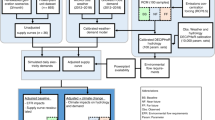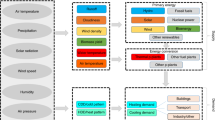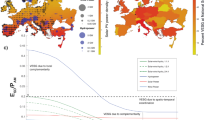Abstract
Impacts of climate-related water stress and temperature changes can cascade through energy systems, although models have yet to capture this compounding of effects. Here, we employ a coupled water–power–economy model to capture these important interactions in a study of the exceedance of water temperature thresholds for power generation in the western United States. We find that not all reductions in reserve electricity-generation capacity result in impacts, and that when they occur, intermittent interruptions in electricity supply at critical times of the day, week and year account for much of the economic impacts. Finally, we find that impacts may be in different locations from the original water stress. We estimate that the consumption loss can be up to 0.3% annually and the drivers identified in coupled modelling can increase the average cost of electricity by up to 3%.
This is a preview of subscription content, access via your institution
Access options
Access Nature and 54 other Nature Portfolio journals
Get Nature+, our best-value online-access subscription
$29.99 / 30 days
cancel any time
Subscribe to this journal
Receive 12 digital issues and online access to articles
$119.00 per year
only $9.92 per issue
Buy this article
- Purchase on Springer Link
- Instant access to full article PDF
Prices may be subject to local taxes which are calculated during checkout





Similar content being viewed by others
Data availability
Source data are provided with this paper. The datasets from this analysis are publicly available. The results of GFDL Sullivan feedback are available at https://doi.org/10.5281/zenodo.5655246. The results of GFDL no Sullivan feedback are available at https://doi.org/10.5281/zenodo.5655255. The WBM output daily discharge and water temperature all GCMs are available at https://doi.org/10.5281/zenodo.5655275. Access to portions of the input data pertaining to the network and hydrogeneration schedules require permission from the Western Electricity Coordinating Council (WECC), https://www.wecc.org/Pages/home.aspx. All remaining data are available upon request from the corresponding author.
Code availability
All code is available from the corresponding author on request.
References
Craig, M. T. et al. A review of the potential impacts of climate change on bulk power system planning and operations in the United States. Renew. Sustain. Energy Rev. 98, 255–267 (2018).
Miara, A. et al. Climate and water resource change impacts and adaptation potential for US power supply. Nat. Clim. Chang. 7, 793–799 (2017).
van Vliet, M. T. H., Sheffield, J., Wiberg, D. & Wood, E. F. Impacts of recent drought and warm years on water resources and electricity supply worldwide. Environ. Res. Lett. 11, 124021 (2016).
Yalew, S. G. et al. Impacts of climate change on energy systems in global and regional scenarios. Nat. Energy 5, 794–802 (2020).
de Nooij, M., Koopmans, C. & Bijvoet, C. The value of supply security: the costs of power interruptions: economic input for damage reduction and investment in networks. Energy Econ. 29, 277–295 (2007).
Sullivan, M. J., Mercurio, M., Schellenberg, J. & Freeman, M. A. Estimated Value of Service Reliability for Electric Utility Customers in the United States (Ernest Orlando Lawrence Berkeley National Laboratory, 2009); https://citeseerx.ist.psu.edu/viewdoc/download?doi=10.1.1.154.3026&rep=rep1&type=pdf
Sanstad, A. H., Zhu, Q., Leibowicz, B., Larsen, P. H. & Eto, J. H. Case Studies of the Economic Impacts of Power Interruptions and Damage to Electricity System Infrastructure from Extreme Events (Ernest Orlando Lawrence Berkeley National Laboratory, 2020); https://escholarship.org/uc/item/9zs9s1x0
Water Quality Standards Handbook (US Environmental Protection Agency, 2017); https://www.epa.gov/wqs-tech/water-quality-standards-handbook
Temperature: Water Quality Standards Criteria Summaries: A Compilation of State/Federal Criteria (US Environmental Protection Agency, 1988).
Joskow, P. L. Restructuring, competition and regulatory reform in the U.S. electricity sector. J. Econ. Perspect. 11, 119–138 (1997).
Van Vliet, M. T. H., Vogele, S. & Rubbelke, D. Water constraints on European power supply under climate change: impacts on electricity prices. Environ. Res. Lett. 8, 035010 (2013).
Macknick, J. et al. Water and Climate Impacts on Power System Operations: The Importance of Cooling Systems and Demand Response Measures (National Renewable Energy Laboratory, 2016).
Grogan, D. S. Global and Regional Assessments of Unsustainable Groundwater Use in Irrigated Agriculture. PhD thesis, Univ. New Hampshire (2016).
Wisser, D., Fekete, B. M., Vörösmarty, C. J. & Schumann, A. H. Reconstructing 20th century global hydrography: a contribution to the Global Terrestrial Network- Hydrology (GTN-H). Hydrol. Earth Syst. Sci. 14, 1–24 (2010).
Stewart, R. J. et al. Horizontal cooling towers: riverine ecosystem services and the fate of thermoelectric heat in the contemporary Northeast US. Environ. Res. Lett. 8, 025010 (2013).
Ho, J. L. et al. Planning Transmission for Uncertainty: Applications and Lessons for the Western Interconnection (Western Electricity Coordinating Council, 2016); https://certs.lbl.gov/sites/all/files/hobbs-planning-transmission-for-uncertainty-final-jan-2016.pdf
Shayesteh, E., Hobbs, B. F. & Amelin, M. Scenario reduction, network aggregation, and dc linearisation: which simplifications matter most in operations and planning optimisation? IET Gener. Transm. Distrib. 10, 2748–2755 (2016).
Munoz, F. D., Hobbs, B. F., Ho, J. L. & Kasina, S. An engineering-economic approach to transmission planning under market and regulatory uncertainties: WECC case study. IEEE Trans. Power Syst. 29, 307–317 (2014).
Munoz, F. D., Hobbs, B. F. & Watson, J.-P. New bounding and decomposition approaches for MILP investment problems: multi-area transmission and generation planning under policy constraints. Eur. J. Oper. Res. 248, 888–898 (2016).
Rausch, S. & Rutherford, T. F. Tools for Building National Economic Models Using State-Level Implan Social Accounts (ETH Zurich, 2009); http://citeseerx.ist.psu.edu/viewdoc/summary?doi=10.1.1.469.6521
Böhringer, C. & Rutherford, T. F. Integrated assessment of energy policies: decomposing top-down and bottom-up. J. Econ. Dyn. Control 33, 1648–1661 (2009).
Acknowledgements
This work was supported by the US Department of Energy, Office of Science, Biological and Environmental Research Program, Earth and Environmental Systems Modeling, Multi Sector Dynamics, contract no. DE-SC0016162. We thank S. Glidden (UNH) who harmonized and geolocated the power-plant database and A. Prusevich (UNH) who ran the WBM for these experiments and generated the data for Supplementary Table 1 and Supplementary Fig. 2.
Author information
Authors and Affiliations
Contributions
M.W., K.F.-V. and R.B.L. conceived and designed the experiments. M.W., K.F.-V., V.K. and R.B.L. analysed the data. M.W., K.F.-V., J.P., V.K. and R.B.L. developed the models and coordinated the model experiments. M.W., K.F.-V. and R.B.L. wrote the paper.
Corresponding author
Ethics declarations
Competing interests
The authors declare no competing interests.
Peer review information
Nature Energy thanks Andres Clarens and the other, anonymous, reviewer(s) for their contribution to the peer review of this work.
Additional information
Publisher’s note Springer Nature remains neutral with regard to jurisdictional claims in published maps and institutional affiliations.
Supplementary information
Supplementary Information
Supplementary Notes 1–8, Figs. 1–9 and Tables 1–5.
Source data
Source Data Fig. 1
Cost and unmet demand of selected scenarios, discrete event counts for unmet-demand episodes.
Source Data Fig. 2
Economic losses from scenarios due to cost only, unmet demand only and both factors.
Source Data Fig. 3
Manufacturing losses by scenario, sectoral losses by sector for one scenario.
Source Data Fig. 4
Economic impacts with and without economic adjustment.
Source Data Fig. 5
Locations of generator outages, congested transmission lines and locations of unmet demand.
Rights and permissions
About this article
Cite this article
Webster, M., Fisher-Vanden, K., Kumar, V. et al. Integrated hydrological, power system and economic modelling of climate impacts on electricity demand and cost. Nat Energy 7, 163–169 (2022). https://doi.org/10.1038/s41560-021-00958-8
Received:
Accepted:
Published:
Issue Date:
DOI: https://doi.org/10.1038/s41560-021-00958-8
This article is cited by
-
Assessing compounding climate-related stresses and development pathways on the power sector in the central U.S.
Mitigation and Adaptation Strategies for Global Change (2024)
-
How climate change affects electricity consumption in Chinese cities—a differential perspective based on municipal monthly panel data
Environmental Science and Pollution Research (2023)



